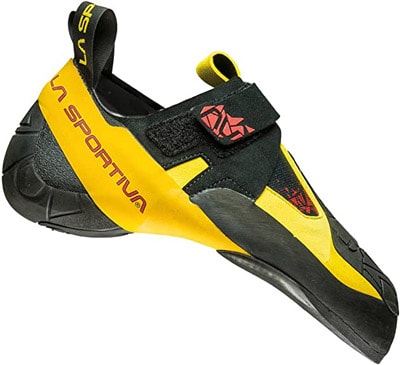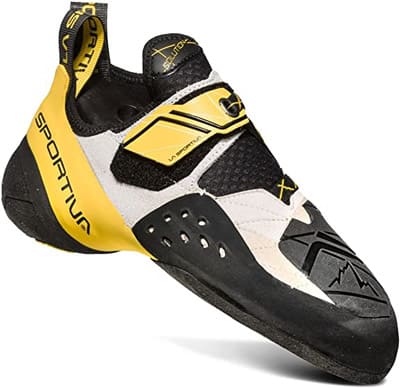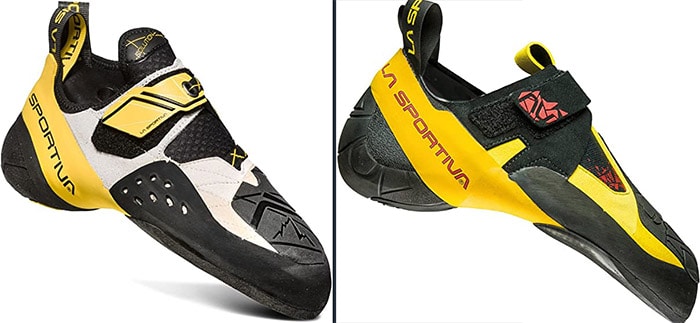When it comes to climbing shoes, one company stands out: La Sportiva. This company is known for making several world-class climbing shoes. Two of the more popular models of the brand are Skwama and Solution. I say that they are popular in the sense that high-profile athletes from around the world have used them.
But what are the differences between Skwama vs Solution? In this article, we differentiate these two highly aggressive and sensitive shoes in terms of features and other related information. After reading this article, you will know the difference between La Sportiva Skwama vs Solution to know the best climbing shoes for you.
| Point of Difference | Skwama | Solution |
| Climbing Usage | Indoor Climbing, Friction Slabs, Overhung Terrain | Overhung Terrain, Bouldering, Technical Sequences |
| Overall Design | Built for Comfort | High-Performance Design |
| Closure System | Uses Single Velcro Strap | Uses Double Velcro Strap |
| Outsole and Midsole | 3.5 mm Vibram XS Grip 2 0.8 mm LaspoFlex Midsole | 3.5 mm Vibram XS Grip 2 1.1 mm LaspoFlex Midsole |
If you take a look at the two climbing shoes side by side, it will be difficult to differentiate with all the similar features they offer. However, if you dig deep and know the features of these two climbing shoes, you will see some differences and uniqueness that we have listed below.
Contents
Climbing Usage

One difference between these two climbing uses is the climbing usage that both provide excellent performance. According to the company, the Skwama was designed for climbing on angled walls.
Meaning, this climbing shoe is perfect for indoor climbing, overhung terrain, and friction slabs. Using this climbing shoe will give you the much-needed flexibility to allow it to adapt to various climbing demands.
On the other hand, the Solution is built with the purpose of navigating the latest bouldering problems. This climbing shoe is designed in such a way that it can be used on overhung terrain, bouldering, and other technical sequences during the climb.
Overall Design
Another difference between these two high-profile climbing shoes is their overall design. When it comes to the Skwarma climbing shoe, its design adds rigidity and support to the overall structure of the shoe.
The manufacturer equipped the shoe with a Vibram sole, a suede leather upper, and a flexible build to combine comfort and performance when being used. The design will also allow you to feel the rock below the surface which allows you to adapt easily during the climb.
On the other hand, the Solution’s design is built on the single-strap and slipper feature that offers a precision fit. The shoe is also wrapped with Vibram rubber and a molded heel cup that provides excellent grip.
Aside from the rubberized sole, this climbing shoe is intended to provide high performance, especially in dealing with the challenges of various bouldering routes. Also impressive is the hoop and loop closure design allows the user to personalize the fitting of the shoe.
Construction and Closure System

Another unique difference between the shoes is their closure system and the overall construction. As for Skwama, the patented heel construction has excellent maneuverability and excellent fits to different climbing surfaces like rock, slabs, and overhands.
The shoe is also built with a split sole construction that allows the shoe to spread out when the climber’s weight is applied eventually. This feature reduces, if not eliminates, the deformation while strengthening the holds.
On the other hand, the Solution features a lining that the Skwama does not have. This lining can be found in the toe box and the arch areas, which provide unique comfort without sacrificing the feel of the shoes. It also allows the show to stay longer on more extended climbing activities.
As far as the closure system is concerned, both these climbing shoes have different ways to do it. Both use the Velcro strap, but the Skwama only uses a single strap, which allows the user to take on and off the feet.
Meanwhile, the closure system of the Solution is a bit more complicated. It is a lock harness closure system that uses two straps instead of one. With this locking system, the user can make more adjustments to the fitting when compared to the single strap.
Outsole and Midsole
With the two shoes’ different usage, it is easy to tell that they have different soles. As for the Skwama, you will find a unique cut on the rubber part at the shoe’s forefoot. This feature will give so much flexibility and excellent contact to the surface, even with varying angles.
The two shoes’ outsole comes very similar, using the Vibram XS Grip 2. According to the company, this feature is the most advanced compound used in a climbing shoe to maximize its performance on steep terrain while providing excellent grip and durability. This feature also allows Skwama vs Solution sizing to be very similar when it comes to fitting.
When it comes to the midsole, these two shoes are unique. The Skwama uses the entire length of 0.8 mm LaspoFlex, while the Solution opts for the 1.1 mm LaspoFlex. With the Skwama’s thinner midsole, it offers extra sensitivity and rigidity.
Which is the Best for your Climbing Needs?
Now that you know the difference between Slwama and Solution, the logical question is, which is the right one for you? The straight answer to this question can be answered by you, your climbing style, and your personal preference.
This article clearly differentiates the two shoes in terms of features and other points of difference. By now, you are probably aware of the different climbing activities these climbing shoes perform at their best. So, that is the key for you when choosing one.
Lastly, these shoes are the aggressive type that best suits intermediate to advanced climbers. If you are just starting, I suggest looking for a more specialized shoe that performs well with the type of climbing you are interested in.
Conclusion
Comparing Skwama vs Solution is just right because both of these popular shoes share the same physical features and functionalities. However, the company manufactured these shoes for different purposes. So learning their differences is essential for choosing the right one for your climbing activity.

